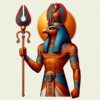Unearthing a Legend: The Discovery of King Tut’s Tomb
The world was forever changed on November 4, 1922, when British archaeologist Howard Carter and his team made an extraordinary discovery in the Valley of the Kings. Beneath layers of sand and stone, hidden for over 3,000 years, lay the tomb of the boy-king Tutankhamun. Unlike many other royal tombs that had been looted in antiquity, Tutankhamun’s tomb was largely intact, preserving treasures beyond imagination.
Who Was King Tutankhamun?
Tutankhamun, often referred to as “King Tut,” ascended the throne of Egypt around 1332 BCE at the tender age of nine. Despite his short reign of about a decade, he played a pivotal role in restoring traditional Egyptian polytheism after the monotheistic revolution led by his predecessor, Akhenaten. Today, King Tutankhamun’s legacy endures as one of the most iconic symbols of Ancient Egypt.
The Discovery: A Treasure Trove Like No Other
When Howard Carter first peered into the tomb and was asked what he saw, he famously replied, “Wonderful things.” And wonderful they were. Tutankhamun’s tomb, designated KV62, contained over 5,000 artifacts, including gilded chariots, exquisite jewelry, ceremonial weapons, and the iconic gold funerary mask that has become synonymous with his name.
Why Was King Tut’s Tomb So Well-Preserved?
Unlike many other tombs in the Valley of the Kings, King Tut’s final resting place was overlooked by grave robbers, possibly due to its small size and hidden location beneath debris from later tomb constructions. This serendipitous concealment preserved the tomb’s treasures, offering a unique glimpse into the opulence of Egypt’s 18th Dynasty.
Exploring the Tomb: What Awaits Visitors?
Today, King Tutankhamun’s tomb remains one of the most visited attractions in Egypt. Located in Luxor’s Valley of the Kings, the site offers an awe-inspiring experience for history enthusiasts and casual travelers alike.
Plan your dream vacation today with our tailored Egypt travel packages.
The Burial Chamber
The highlight of the tomb is undoubtedly the burial chamber, where the sarcophagus and inner coffins were found. Visitors can still see the wall paintings that depict Tutankhamun’s journey to the afterlife, showcasing vibrant colors and intricate details that have stood the test of time.
The Artifacts
While most of the treasures from the tomb are housed in the Egyptian Museum in Cairo and the Grand Egyptian Museum in Giza, replicas of some artifacts are displayed at the tomb site, providing a sense of the grandeur and sophistication of Ancient Egyptian craftsmanship.
The Mummy
King Tutankhamun’s mummified remains are on display within the tomb, offering a poignant reminder of the boy-king’s humanity amidst the grandeur of his burial.
Fun Facts About King Tutankhamun’s Tomb
- Size Matters: King Tut’s tomb is relatively small compared to other royal tombs, leading many to speculate that it was originally intended for someone else.
- The Curse of the Pharaohs: The discovery of the tomb popularized the myth of a curse, as several individuals connected to the excavation died under mysterious circumstances.
- A Golden Mask: The famous gold funerary mask weighs about 10 kilograms (22 pounds) and is inlaid with semi-precious stones.
How to Visit King Tutankhamun’s Tomb
Visiting King Tutankhamun’s tomb is a must for anyone traveling to Luxor. Here’s what you need to know:
Best Time to Visit
The best time to visit the Valley of the Kings is during Egypt’s cooler months, from October to April. Early mornings are ideal for avoiding crowds and the midday heat.
Getting There
The tomb is located on the west bank of the Nile in Luxor, about 10 kilometers from the city center. You can reach the site by taxi, organized tours, or even a scenic Nile cruise.
Tickets and Accessibility
Visitors can purchase tickets for the Valley of the Kings, which includes entry to several tombs. A separate ticket is required for King Tutankhamun’s tomb. Note that photography inside the tomb may require an additional fee or special permit.
Why Is King Tutankhamun Still Relevant Today?
King Tutankhamun’s legacy transcends history, influencing art, culture, and popular imagination worldwide. The treasures from his tomb have been exhibited globally, drawing millions of visitors and sparking renewed interest in Ancient Egypt.
Cultural Impact
From Hollywood movies to countless books and documentaries, King Tutankhamun’s story continues to captivate audiences. The discovery of his tomb marked a turning point in the field of archaeology, inspiring generations of explorers and historians.
Modern Research
Advances in technology have allowed researchers to learn more about King Tutankhamun’s life and death. DNA studies and CT scans suggest that the boy-king suffered from several health issues, including a clubfoot and malaria, which may have contributed to his untimely demise.
Tips for an Unforgettable Visit
- Hire a Guide: A knowledgeable guide can bring the history and significance of the tomb to life.
- Wear Comfortable Shoes: Exploring the Valley of the Kings involves a fair amount of walking.
- Stay Hydrated: The desert heat can be intense, even in cooler months.
- Plan Ahead: Book tickets in advance to ensure entry, especially during peak tourist seasons.
Conclusion: A Timeless Wonder
The tomb of King Tutankhamun is more than just a burial site; it’s a portal to a bygone era of splendor and mystery. Whether you’re a history buff or simply looking for an unforgettable travel experience, a visit to King Tut’s tomb promises to be a journey like no other.
Ready to Explore?
Don’t miss the chance to walk in the footsteps of history. Book your Luxor day tour and discover the magic of King Tutankhamun’s tomb for yourself.





